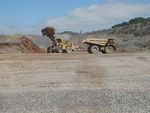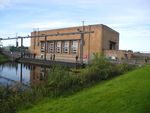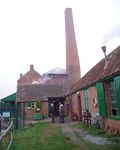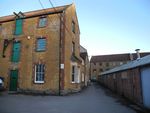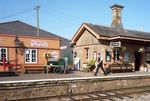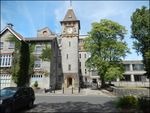Association for Industrial Archaeology 2019 Conference, Cannington, Bridgwater
←
→
Page content transcription
If your browser does not render page correctly, please read the page content below
Association for Industrial Archaeology 2019 Conference, Cannington, Bridgwater
Tour Programme
Sunday 11th August, 13.00 - 18.00
Tour A: Bridgwater, Town, Docks and Brick & Tile Museum
This walking tour of central Bridgwater will include a visit to
and demonstration of tilemaking at the Brick and Tile Museum
(https://swheritage.org.uk/our-sites/brick-and-tile-museum)
(ST300376). The museum is based around a brick kiln which is
the only survivor of the vast number that used to surround
Bridgwater and has limited normal opening. The town walk will
be led by SIAS members and will include the docks of 1841
with 2 locks to the tidal R Parrett and a bascule bridge, ware-
houses, feed mill, base of the 1720 glass cone, the telescopic rail-
way bridge, river quays, Town Bridge, Castle House - an early ex-
periment in reinforced concrete, the Bridgwater & Taunton Canal
in a deep cutting, and finishing back near the docks. A leisurely
fairly level walk of about 2 miles.
Tour B: West Somerset Railway and Workshops
The journey to and from the railway will be by heritage coach
around the northern end of the Quantock Hills with views over
the sea. The West Somerset Railway is the longest heritage rail-
way in the country and there is much to see. (https://www.west-
somerset-railway.co.uk) At Minehead (SS974464) there will be a
tour of the Locomotive Department’s workshops and facilities
before catching a mid-afternoon steam train back along the
coast to Williton. The station at Williton (ST085417) was
originally broad gauge and is beautifully restored; it includes
the last remaining working signal box of the Bristol & Exeter
railway. There are also a number of restoration workshops
including a listed building relocated from Swindon. There
will be a tour of some of the facilities before returning by
heritage coach to Cannington.
Tour C: Fox Bros, Wellington and Coldharbour Mill, Uffculme
The tour will start by visiting the original Fox Bros premises
in Wellington - Tonedale and Tone Works (ST128214 &
ST126218). Fox Bros was the largest integrated woollen mill
in the west of England and both parts of the mill complex are
extremely important. Both have been the subject of abortive
redevelopment proposals and are deteriorating. We will
probably only be able to have external views. The local au-
thority has appointed a Heritage at Risk Officer and she will join
us and give us an update on the current situation. From there the
tour will go to Coldharbour Mill Museum at Uffculme
(ST063122) which was part of Fox Bros originally. It is now
preserved as an operating museum.
(https://www.coldharbourmill.org.uk)Monday 12th August, 09.00 - 18.00 Tour D - Land drainage pumping stations Much of the Somerset levels are below sea level and rely on pumped drainage; the tour will include a variety of pumping stations, explanation of clyses and rhynes, a visit to the Envi- ronment Agency to see and hear how they deal with flood & water management today, and a visit to Westonzoyland Pumping Station museum. The tour will start at Gold Corner Pumping Station (ST367431) dating from 1941/2 where the original Crossley diesels have been replaced by electric mo- tors which still drive the Sulzer pumps. From there we will visit the EA Flood Incident Room at Bridgwater (ST300376). Lunch will either be in the EA canteen or locally. Then to Currymoor Pumping Station (ST345288) where there are successive generations of equipment including a preserved Easton steam drainage machine of 1864, disused Ruston & Hornsby vertical diesels, an Archimedean screw pump from the 1970s, and modern electric motors. From there we go to Weston- zoyland Pumping Station Museum (ST340328) which will be in steam. This is based around the oldest engine house containing its original steam engine (Easton, Amos 1861) in Somerset and the museum has the largest collection of working stationary steam engines and pumps in the South of England. (https:// www.wzlet.org) Tour E - Rural Somerset industries - especially cider and willows The tour starts with a visit to Chard Museum (ST319086). This is quite extensive for a local museum (https:// www.chardmuseum.co.uk) and includes displays on Stringfellow - who demonstrated the world’s first powered flight, in Chard; Gillingham - who pioneered artificial limbs; as well as other local engineering and lace indus- tries. From there we travel to Hornsbury Mill restaurant (https://www.hornsburymill.co.uk)(ST333108) where we have a buffet lunch (included) and a chance to look at the wheel and surviving machinery. After lunch the tour will visit Burrow Hill Cider Farm and cider brandy distillery (ST415200). We will have a guided tour of this traditional cider maker with the country’s only cider brandy distillery (https://www.somersetciderbrandy.com). From there the final visit of the day will be Coates Willow centre & museum (https://www.englishwillowbaskets.co.uk) (ST337269) at Stoke St Gregory. The Somerset levels are the heart of the English willow industry and Coates includes withy boilers, different ages of willow stripping machines, charcoal manu- facture and a museum. There is also a tea room for afternoon refreshments. Again, we will be having a guided tour.
Tuesday 13th August, 09.00 - 18.00 Tour F - Brendon Hills Iron Mining & West Somerset Mineral Railway This tour will be led by members of the West Somerset Mineral Line Association, and involves a fair bit of walk- ing, some on rough ground, so stout footwear is advisable. The Brendon Hills had extensive iron mining in the mid- nineteenth century by the Ebbw Vale Co served by a rail- way from the mines down to the Bristol Channel at Watchet. The railway featured a stupendous incline to get down from the hills with a vertical rise of over 800’ and a length of 1100 yds. There are a number of sites to visit but some will depend on weather and access permission on the day. In the morning it is intended to visit Langham Hill mine (SS978356), Bearland Wood ventilation fur- nace (possible), and Burrow Farm engine house (ST008346). A buffet lunch will be taken at the Ra- legh’s Cross Inn (included). After lunch we will visit the site of Brendon Hill miner’s village, Beulah Chapel, Ralegh’s Cross mine, Comberow incline including the winding house (ST023344) and the top of the incline, and possibly Carnarvon mine and Brendon Hill Station. We then travel to the other end of the Mineral Line at Watchet to see Watchet harbour (ST072435), Watchet WSMR station, and Watchet museum. (www.westsomersetmineralrailway.org.uk) Tour G - Industries of the Yeovil area including flax, gloving and engineering The first brief stop will be at a clutch of system built Nissen houses at West Camel (ST579252). From there we travel to the reserve collection of the Navy Aviation Museum at Yeovilton; this is in a purpose built store, Cobham Hall (ST556245), and has over 30 historic aircraft, the first air- craft carrier, and many other artefacts (https:// www.fleetairarm.com). From there we go to the CHAC (Community Heritage Access Centre) (ST522168) which is run by the local authority. CHAC is a reserve store of artefacts covering many aspects including local indus- tries such as gloving, Petter’s/Westland’s (engineering and helicopters), St Ivel dairies, and the flax and twine industries. We then travel to West Coker and Dawe’s Twine Works (ST513136) (www.westcoker.net/home- page/ropewalk). We will have a buffet lunch in their visitor centre as soon as we get there (included) before tours around the works. Dawe’s twineworks featured on Restoration on TV; it is now recently restored to work- ing order by a Trust. We travel back to Cannington over Ham Hill and the landscape of old quarries; and a brief stop at Stoke-sub-Hamdon (ST473173) to see converted glove factories and a fives wall.
Wednesday 14th August, 09.00 - 18.00 Tour H - Mendip Quarrying Somerset contains 2 of the 3 biggest quarries in the country and Mendip stone has been exported to the South-east by rail since 1865. The Quarry Faces project on Mendip Stone identi- fied over 75 closed or active quarries and assembled a large amount of oral history and historic images of the quarries. We start by visiting the Earth Science Centre (ST662457) where, over a cup of tea, we have a short talk using some of the many historical quarry images collected as part of the Quarry Faces project. We then visit the viewing platform at Whatley Quarry (ST725480) - one of the 2 biggest quarries. We return to the ESC for a buffet lunch (included). Then we travel to Asham closed quarry (ST710456) for a guided tour of typical quarry features. The rest of the afternoon will consist of a visit to the East Somerset Railway (https://eastsomersetrailway.com) (ST666430). Cranmore station was the first station to dispatch stone by rail and is now the headquarters of the ESR. We will have a trip on this heritage railway, including a visit to the engine shed and works. We return to Cannington via Bridgwater station for drop off for local trains to Taunton and Bristol. Tour I - Mid Somerset Industries - shoes, beer, horsehair and flax We start at Clarks in Street (ST484367). Clarks are synonymous with Street and much of it was built by the firm including workers housing, lido and community facilities. The old factory still contains a stationary steam engine preserved and hidden in the interior, and the shoe museum. We will split into three groups to visit the engine, to visit the shoe museum and for a short guided tour of elements of the factory town; each group will do all 3 activities in turn. We then travel to Shepton Mallet for a walk around the Anglo-Bavarian Brewery (ST615437). The ‘Anglo’ was a nationally important brewery and is a colossal building of 1864/72 which closed in the 1920s and is now a trading estate. We travel to Castle Cary where after viewing the exterior of Boyd’s old horsehair factory of 1851 we will have a buffet lunch in the George Hotel (included). We then visit the small museum in Castle Cary before arriving at the current Boyd’s horsehair factory. Note that this visit includes steep and nar- row steps (www.johnboydtextiles.co.uk) (ST635324). Castle Cary has long been a centre for horse-hair weaving and Boyd’s still continue, relocated to a former flax mill but still using 19C looms, and now the only mechanical horse-hair weaving in the world. We return to Cannington via Castle Cary station (for drop-off for trains for London, Exeter and the west); Eli’s, the Rose & Crown at Huish Episcopi for re- freshments/toilets (an important pub interior without a bar counter); Langport (brief stop to see a number of features); and Bridgwater station to drop off for local trains.
You can also read




